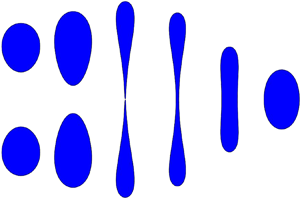Article contents
The corotating hollow vortex pair: steady merger and break-up via a topological singularity
Published online by Cambridge University Press: 18 November 2020
Abstract

The shapes of two steadily rotating, equal circulation, two-dimensional hollow vortices are determined and their properties examined. By means of a numerical scheme that accounts for the doubly connected nature of the fluid domain, it is shown that a one-parameter family of solutions exists that is a continuation of a corotating point-vortex pair. With  $b=2$ set as the distance between the vortex centroids, we find that each vortex reaches a maximum possible area of
$b=2$ set as the distance between the vortex centroids, we find that each vortex reaches a maximum possible area of  $0.796$ corresponding to
$0.796$ corresponding to  $a/b=0.260$ where
$a/b=0.260$ where  $a$ is a measure of the vortex core radius proposed by Meunier et al. (Phys. Fluids, vol. 14, 2002, pp. 2757–2766). Results are compared to those of a previous study by Saffman & Szeto (Phys. Fluids, vol. 23, 1980, pp. 2339–2342) in which two corotating patches of uniform vorticity are considered in place of the hollow vortices studied here. The general behaviour of the two systems is seen to be similar but some differences are highlighted, especially when the vortices become close to touching due to the accumulation of vorticity in thin extended fingers emanating from each of the vortices. The numerical scheme captures the family of equilibria very close to a critical configuration where these fingers tend to touch at the centre of rotation corresponding to
$a$ is a measure of the vortex core radius proposed by Meunier et al. (Phys. Fluids, vol. 14, 2002, pp. 2757–2766). Results are compared to those of a previous study by Saffman & Szeto (Phys. Fluids, vol. 23, 1980, pp. 2339–2342) in which two corotating patches of uniform vorticity are considered in place of the hollow vortices studied here. The general behaviour of the two systems is seen to be similar but some differences are highlighted, especially when the vortices become close to touching due to the accumulation of vorticity in thin extended fingers emanating from each of the vortices. The numerical scheme captures the family of equilibria very close to a critical configuration where these fingers tend to touch at the centre of rotation corresponding to  $a/b \approx 0.283$. By a simple adaptation of the numerical scheme to compute
$a/b \approx 0.283$. By a simple adaptation of the numerical scheme to compute  $2$-fold rotationally symmetric equilibria for a single rotating hollow vortex we then show that its limiting configuration is one where a thin waist forms leading to two separate parts of its single boundary drawing close together. We give evidence that the limit of this single vortex configuration coincides with the limit of the two-vortex configuration. The limiting configuration itself turns out not to be physically admissible, leading to what we refer to as a topological singularity since no physical quantities blow up, indeed they appear to be continuous as the limiting state is approached from the two topologically distinct directions.
$2$-fold rotationally symmetric equilibria for a single rotating hollow vortex we then show that its limiting configuration is one where a thin waist forms leading to two separate parts of its single boundary drawing close together. We give evidence that the limit of this single vortex configuration coincides with the limit of the two-vortex configuration. The limiting configuration itself turns out not to be physically admissible, leading to what we refer to as a topological singularity since no physical quantities blow up, indeed they appear to be continuous as the limiting state is approached from the two topologically distinct directions.
JFM classification
- Type
- JFM Papers
- Information
- Copyright
- © The Author(s), 2020. Published by Cambridge University Press
References
REFERENCES
- 2
- Cited by



